|
|
FOSTERING YOUNG
Like most animals, if you find a litter of rats, it's best to leave them where you've found them unless you're certain that the mother is no
longer with the living. Mother rats can't be with the babies all of the time because she has to go out in search of food and because her presence
alone attracts predators. Rat moms care very much about the welfare of their children and will willingly risk their own lives to save the
lives of their young. Not to mention, as nice or as curious as you may be, you really don't want to maintain a mom-rat's feeding schedule...trust me :o)
So, again, if you see a litter of rats, just put everything back into place and the mom will return and gather them up and move them (if she
perceives their location is no longer secure) or will simply go back to her business of feeding them and caring for them. Oh, and don't worry
about it if you've touched them - just like us human types, a bad or foreign smell isn't enough to make a rat mom give up on her duties.
I repeat myself because nobody ever seems to believe me: just leave them there!! Of course as humans, once we know about something, we always
have to do something about it so... check up on them in about 6 hours. If mom was back to feed them, you should see a white crest through the skin of
their bellies, right below their rib cage. If you see that crest, you needn't worry any longer: Mom is somewhere and she's doing her job.
If you don't see the crest, or if you know mom is no longer one of the living, here's what you need to do if you don't know of any
lactating mom-rats out there:
Quicklinks (the big summary):
1. Try to determine their age (approximately - development times may vary):
* Body length measurements are "sans tail."
Eyes are Closed: The babies are 0 - 13 days old.
|
0 - 2 days old: The babies are pink, no fur, no whiskers, and the ears are essentially unformed.
Body length is approximately 3.2 - 5.1 cm (1.25 - 2.00 in).
Weight is approximately 7.2 - 9.0 g (0.25 - 0.30 oz).
|
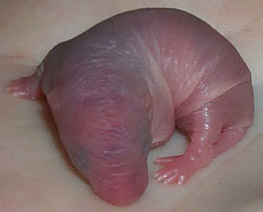
|
|
3 - 5 days old: The babies have color, essentially no fur or very short bristles of fur, the whiskers are light and
faint, and the tips of the ears are starting to poke out.
Body length is approximately 6.4 - 7.6 cm (2.50 - 3.00 in).
Weight is approximately 9.8 -11.3 g (0.35 - 0.40 oz).
|
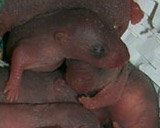
|
|
6 - 7 days old: The babies have color and a coat of bristly short fur, the whiskers are light and faint and
the ears, though still mostly attached, are starting to look like ears.
Body length is approximately 8.9 - 10.2 cm (3.50 - 4.00 in).
Weight is approximately 12.4 - 13.5 g (0.44 - 0.48 oz).
|
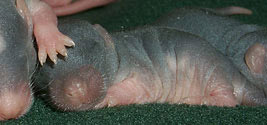
|
|
8 - 13 days old: The babies have color and a significant coat of short fur, the whiskers are obvious, the ears are
freeing themselves from the rat's head, and the babies are mobile and more exploratory.
Body length is approximately 10.8 - 14.0 cm (4.25 - 5.50 in).
Weight is approximately 16.2 - 25.0 g (0.57 - 0.88 oz).
|
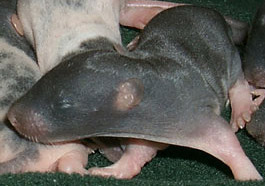
|
Eyes are Open: The babies are 14 - 21 days old.
|
14 - 15 days old: Open is a relative term - the eyes are slits at best, they're exploratory, they have fur even on
their ears, and their whiskers are proportionally long.
Body length is approximately 14.0 - 14.6 cm (5.50 - 5.75 in).
Weight is approximately 26.4 - 28.0 g (0.93 - 0.99 oz).
|
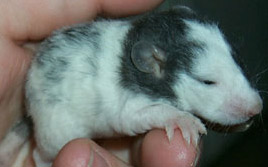
|
|
16 - 17 days old: The eyes look 'sleepy' but they're open, they're starting to wander out and test things for
themselves, their ears are now totally functional (they don't look like little fat slivers but rather like rodent ears with contour, etc),
they have fur, they explore, etc, etc.
Body length is approximately 15.2 - 15.9 cm (6.00 - 6.25 in).
Weight is approximately 28.9 - 30.3 g (1.02 - 1.07 oz).
|

|
|
18 - 20 days old: Their teeth are still not ready for the real world, but they've been practicing. The stronger
of the bunch are extending their explorations much further outside of the nest.
Body length is approximately 16.5 - 17.8 cm (6.50 - 7.00 in).
Weight is approximately 32.5 - 37.0 g (1.15 - 1.31 oz).
|
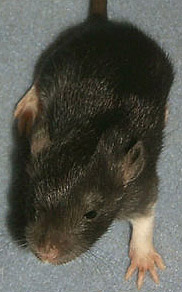
|
|
21+ days old: For a wild rat, this is pretty much the 'get up and go' time. Mom's exhausted and the bubs
are quite ready to really get involved with the day-to-day chores like helping to feed the family, take out the garbage, etc. Eyes are open, ears
are formed, teeth work, they have fur, etc, etc.
The following data is "to 31 days:"
Body length is approximately 18.4 - 24.8 cm (7.25 - 9.75 in).
Weight is approximately 39.4 - 62.4 g (1.39 - 2.20 oz).
|

|
2. Figure out where they're coming from. If you found them in a group, in a nest, you know where they came from. But what if you find just
one or two?
Eyes are Closed: Mom was transporting babies from point A to point B. Something spooked her and she dropped a baby (or a
pet cat or dog carried it in). Last you checked this is your house and you don't want rodents clambering about. Try to find out where mom came from and where she was going. You want to do this because dead animals smell and because you
want to help.
Eyes are Open: Mom could have been transporting but check the immediate area first. Once their eyes have opened, they tend to
explore a bit more and the longer they've been exploring, the further out they'll venture. If you can find out where they ventured from, you can
capture the litter before they wander too far and prevent the conversion of your house into a veritable rat playpen (their sense of fashion and
style generally does not tend to match our own).
3. Go shopping. Here's what you need (and what to do with these things):
Formula: In order of preference, Isomil or Soyalac (human milk replacer alternative), Enfamil (human milk replacer, without
iron), Esbilac (puppy milk replacer) mixed with MultiMilk (half and half, or just Esibilac), KMR (kitten milk replacer).
- Since the required portion size will be pretty small, it's best to acquire your chosen formula(s) in powdered form.
- A mixture may prove to be better than a single product. The make-up of a rat mother's milk (like our own) changes as the
babies grow in order to better meet their needs.
- You can prepare the formula per the instructions. If you see runny stool, however, try diluting it some (for example,
add twice as much water) and gradually move back up to the suggested mixture.
- The formula should be warm (not hot, not cold). Since it's such a small amount, it'd probably be easier to either run
very hot tap water over the syringe or to soak the syringe in a bowl of previously boiled water. Place a drop of formula on your wrist to make
sure it's not scalding-hot.
- They feed in any odd position except completely upside down. It's probably easiest for you to have them in your
fist 'standing up' but they can feed lying on their belly or on their back as well. Once they're used to the formula, it doesn't really
matter - they'll be grabbing for the syringe to get at the formula.
- There is such a thing as too much, too fast. Diarrhea usually means "too much." Milk bubbling though nose usually means
"too fast." Feed carefully!
- How much to give, and how often, below:
Something to feed with: Rats are small (and mice even smaller) so you have to be creative. Try a syringe with an absorbent
small cotton rope, a small icing tube (icing removed of course), an eyeshadow applicator, a child's toy baby bottle, a small rubber tube, or any
combination of the above. The idea, of course, is to make some kind of contraption that you can hold, that you can dispense formula out of at an
even pace, that will fit into a mouth with an opening ½ the size of a coffee straw, and that the tiny mouth can also suckle on.
Rehydrating solution: Pedialyte or Gatorade, Lactated Ringer's Solution, or, if all else fails, make your own by mixing 8 oz.
of water with 1/3 tsp of salt and 1 tsp of sugar.
Formula is not designed for rats - it is close to, but not exactly like, a mother's milk. As such, the introduction to a
formula-based diet must be done so gradually and while going through this adjustment period, in an attempt to avoid dehydration (and to compensate
for the diarrhea that is likely to accompany the change in diet), you need to start them off with an electrolyte solution and ease them onto formula.
Using a clean (boiled - sterilized) syringe, eyeshadow applicator (etc -
whatever you chose as your feeding utensil), feed the baby pedialyte or gatorade for the first 12-24 hours or so while slowly adjusting the
portions as you go. For example, if you need to feed 2 cc of formula, start with 2 cc of pedialyte at hour 0, 1
¾ cc pedialyte and ¼ cc formula at hour 4, 1 ½ cc pedialyte and ½ cc formula at hour 8, 1 cc pedialyte and 1 cc formula
at hour 12, and so on.
Since you'll be following each feeding with a bathroom break, you can use the results of the potty escapade to determine how well they're adapting
to formula. See below.
Potty training utilities: Cotton swabs. Many small animals can't potty on their own right away. Their mothers, after feeding
them, will flip them over and lick their privates in order to stimulate their bathroom habits. Without this, they will die. You needn't lick them
yourself, however: just grab a cotton swab, run it under the faucet, and rub the genitals and anus in small circles for a few minutes to stimulate
the activity. Urine should be fairly clear while feces should be a golden yellow-brown.
Makeshift secure home: Baby rats basically require some space, fluff, warmth, and a bit of darkness. You require security so
as to avoid having baby rats running amok. So you'll want...
External heat source: They're not reptiles or chickens so a heat lamp or light won't do the trick. You'll want either a
heating pad or a microwaveable sand bag - rats cannot maintain their own body temperature on their own until they've got full fur coats (if
they're moving about, they don't need the heating pad) so you do need to provide heat from an external source.
- The setting on the heating pad should be "low" - the body temperature of the rats should be between 96.6° F and
99.5° F (35.9° C - 37.5° C).
- Place the heating pad below (outside) the cage bottom.
- Place the box in the cage above the heating pad - it will absorb the heat and the heat will spread across its surface.
- On the inside of the box, place some stretched out cotton balls, paper towels, etc and create a 'bowl' out of it - cotton fibers will also
absorb and dissipate heat effectively.
- Place the rats in the 'bowl' using a bit of the fluff to cover them.
Note: A higher setting will result in roasted rodents (or very bad skin burns) as they don't move that much initially. Make sure to rotate
them and make sure, as you needn't use the exact setup described above, that there is enough distance between the heating pad and the rat not to
do excessive damage!
4. Prepare for their future:
Prepare for independence: Once their eyes are open, they need to be exploring with all of their senses. Wild rats live on the
ground, they touch dirt and leaves and wood. Rats are omnivores - they try everything and the broader their experience with trustworthy foods, the
greater their chance for survival.
So, think deeply about the natural world around you and start collecting branches, soil, rocks, leaves, bugs,
grain, berries, edible flower buds, vegetables, grass, acorns and other nuts and add those things to your secured environment for them to explore
(they'll forgive you if you skip the bug thing).
Also, save bottle caps and jar lids - you can use these as flat dishes in which you can place thin layers of bread soaked in formula or soy
milk. You want flat lids because you don't want the little babies to drown. But you do want then to start becoming self-sustained so this will
enable them to start feeding themselves (and allowing you more time to sleep)!
Handling: If you don't want new roommates, you need to try to avoid handling them as much as possible (tricky when you're
feeding them every 4 hours). You're a nice human but most humans are not like you. So once they're around 3 weeks old, and cute and
irresistible, you need to remember to promote their independence and future success by not handling them at all. They need to be afraid - that's
how they survive. This includes letting them play with other family members and pets. They need to be afraid of everything and everyone!
And whatever you do, don't trick yourself into believing that they're tame: They're not! They're nice at 3 weeks because there
isn't much they can do to fight back. Besides, they're trapped and they aren't aware of all the options. But if you wait around for that little
jaw of theirs to become strong, you'll find out the hard way that they don't want to be held captive, that their place is not in your home, and
that they are ready to explore the world around them.
5. The release:
How: You need to acclimate them to the outdoors, sight, sound, and feel. You've already been working on the feel by
bringing bits and pieces of the outdoors inside for them to explore. So what you'll want to do next (around day 21) is to start moving them closer
to the outside, either closer to an open window or closer to a door. If it's winter, make sure there's a lot of mud and paper, etc in your
contained environment. If it's summer, make sure there's shade. At 4 weeks of age they should be spending at least half of their day outdoors
(preferably from midnight to early morning/afternoon or from early evening to midnight) to help them become accustomed to the sights and smells.
When: It's best to release them at dusk. Rats are essentially nocturnal, they can see better at night (they see blues, purples, and ultraviolet), and they have less
chance of being spotted by predators at night as well. So, somewhere during that 4th week*, make
it a long half-day of outdoor living and find a tree or well-covered area in a wooded area far enough away from a roadway (see ratbehavior.org for some pictures of what nature-provided rat homes
look like (not the boxes, obviously)), open the cage door, and scare them into scattering (or just patiently wait - they'll wander out). Once
they've left your confined environment, take the contents of their cage, and dump it in a pile on top of a big rock (they begin to dig all tunnels from
beneath a big rock), or near a tree or bush so, if they so choose, they can use familiar materials to create their new home.
Of course, you need to account for weather (which I've personally found is more painful than preparing for their readiness). Snow and ice are
problematic, rain is problematic, excessive heat is problematic. If it's in the middle of winter, they have no food stored up. If it's
excessively hot, are they close enough to a safe water source? If it's raining or the ground is very wet, they can't dig their tunnels. Etc, etc,
etc.
* You need to use your best judgement on this one. A 4-week old may still be too small and/or too weak to fend
for himself out in the wild. Obviously, if they're really fast and biting everyone and everything, they're ready. And if they have a family to
depart with (you've caught older family members in their, uh...your, home), they're probably ready to move on.
But you have to ask yourself: Are their teeth sharp enough and their jaws strong enough to chew down wood, hard foods, etc? Are their arms and
legs strong enough to burrow through the ground to create shelter for themselves? Are their arms and legs fast enough to carry them quickly away
from predators? If the answers are yes, yes, yes, they're ready to go, go, go. If there are any doubts, they may need a couple of days.
Or, perhaps, one or two may be better off simply not being released - one reason why there are pet rats is because they do have an uncanny
knack for finding love in all the wrong places. If you have an exceptionally weak guy or an exceptionally trusting gal, you might be better off
finding someone who will worm them and take them into their home.
Of course, as much as it hurts to think about it, that's also part of nature: The strong survive and the weak contribute to the livelihood of
the strong by becoming part of the food chain and most wild animals would choose a life of freedom over one of captivity even if it is
short-lived. So don't feel bad if you don't know: You gave them all a chance they otherwise wouldn't have had and it's up to them and fate now.
Where: Hopefully by now you've found out how they got into your house in the first place. If so, and if those spots have
since been secured, you can simply release them in your back yard (though the risk of your neighbors finding and killing what you've worked so
hard to save is pretty great). Better yet, try to find a park, wilderness/nature preserve, wooded area, forest, etc, etc about a mile away
from you - some place similar to where you live (same temperature, same lousy weather, same resources) where there is a source of water (an active
puddle, a poor sewage drainage water-collects-there puddle with life forms nearby, a pond, a lake, a river, etc) close by (you can see it).
Wherever there is water, there is nature and thus food. Make sure near this water source there is a means of building a home too (trees,
rocks, bushes, etc). And make sure it's not close to a restaurant, home, or storefront (otherwise they'll aim for the easier option and just
move in there and find their lives drastically shortened).
Other useful references:
Oh, and here's what you probably don't want to do:
1. Deliver them to a pet store. If you have a friend who has a lactating rat, having that rat take on the litter and care for that litter
is an excellent and viable option. If, however, the only lactating rat in town is a rat in a pet store (good probability on that one as pet stores
just hate to separate genders it seems), you're not saving a life, but rather, feeding a snake. Not good.
2. Deliver them to a shelter or humane organization. Humanity is selective. Nobody cares about rats or mice. If you deliver them to your
city's humane organization, they will turn around and feed whatever they have at that location that eats rats and mice or they'll deliver them to
another shelter who has animals that eat rats or mice, or they'll turn around and deliver them to a wildlife rehabber who rehabs 'important'
animals like hawks so that they don't run out of food.
3. Deliver them to a wildlife rehabber. Wildlife is also selective. There is worthwhile wildlife (cute little squirrels, bunnies, and
birdies, essential and beautiful big birds like hawks and raptors, interesting animals like bats, snakes, and frogs, etc) and then there are rats
and mice. If you call a wildlife rehabilitation center and you tell them you've found rats, they'll either offer you advice on how to kill them,
sound like you just said "cockroaches" and hang up on you, or they'll offer to take them off of your hands because they have hungry owls to feed
(they'll not always provide you with an explanation though).
And this is precisely why it's a brilliant idea to leave them where you found them in hopes that mom is still around to feed them: If you want to
help, you're basically on your own. Sad but true.
|
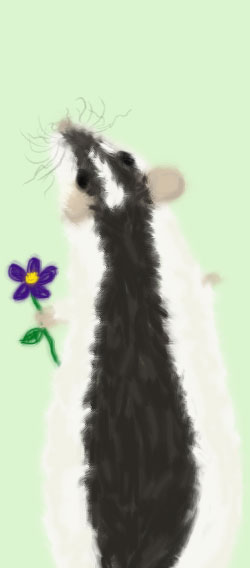
|

